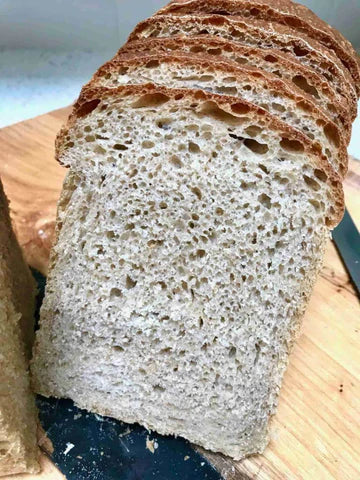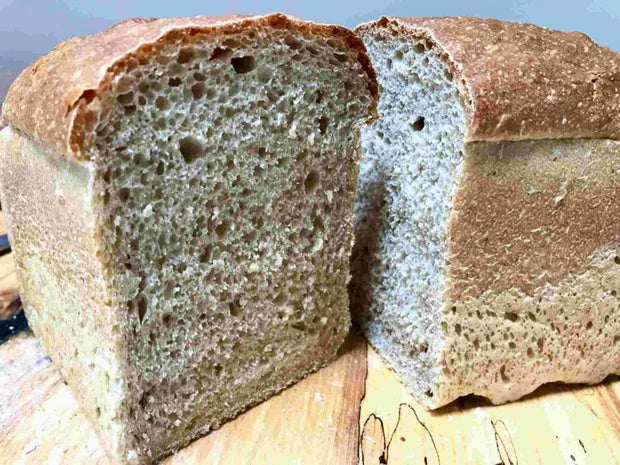Makes 1 standard loaf
Time: up to 24 hours; hands on time: 30 minutes.
Essential equipment for this recipe: 23x10x10cm loaf tin, prepared as per manufacturers guidance



Makes 1 standard loaf
Time: up to 24 hours; hands on time: 30 minutes.
Essential equipment for this recipe: 23x10x10cm loaf tin, prepared as per manufacturers guidance
60g active starter
200g strong white flour
400g Cotswold spelt and rye flour
420g water
1 ½ tsp salt or to taste
Cotswold Spelt and Rye Sourdough Sandwich Loaf









Makes 1 standard loaf
Time: up to 24 hours; hands on time: 30 minutes.
Essential equipment for this recipe: 23x10x10cm loaf tin, prepared as per manufacturers guidance
60g active starter
200g strong white flour
400g Cotswold spelt and rye flour
420g water
1 ½ tsp salt or to taste
This flour produces a wonderfully tasty loaf, whether used alone or in conjunction with another flour as I have done here. The mix will be sticky and heavy and grows to a smooth firm dough, baking to a soft, slightly moist, lovely sandwich loaf.
Want some great insights into the magical world of sourdough baking? Visit out Sourdough Section now to signup for regular sourdough recipes, offers, and content from our Sourdough Brand Ambassador Elaine Boddy!
Step 1: late afternoon, mix all of the ingredients to make a rough dough, with no dry flour showing. This will be quite a heavy dough. Cover the bowl with a shower cap or cover, and leave it to sit on the kitchen counter for 2 hours.
Step 2: perform the first set of pulls and folds on the dough to build up its structure. Literally pick up a handful of dough from one side of the bowl, using your thumb and two forefingers to grab a portion, lift it, stretch it and fold it over the rest of the dough to the other side of the bowl, turn the bowl a few degrees and repeat the process, lift and fold, turn the bowl, lift and fold, turn the bowl, and continue until the dough comes together into a smoothish ball. Then stop. This will be a heavy textured dough.
Cover the bowl again and leave it out on the kitchen counter. You can now leave the bowl again for an hour, or half an hour, whatever works for you.
Step 3: over the next few hours, at intervals that suit you, perform 3 more sets of the lifting and folding action, just enough to bring the dough into a ball; this is the dough telling you when it is time to stop. After each set, cover the bowl and leave it on the counter doing the final set before going to bed.
This dough will remain heavy, it will become smoother as you work with it, and will end up being silky and nicely stretchy by the final couple of sets of pulls and folds. Each time it will hold a ball easily.
Step 4: leave the covered bowl on the counter overnight to prove. I typically let my dough prove, untouched, for 8 to 10 hours at temperatures of 18-20C. If it has been colder, it may need longer; if it is warmer, you will need to make amendments to the dough at the start of the process.
Step 5: in the morning, the dough will be grown to double, maybe even slightly more than double, with a smooth slightly upwardly domed surface. Have your loaf pan ready. Gently lift and fold small handfuls of dough from one side of the bowl into the middle in a line, using the same pulling and folding action as used previously; turn the bowl 180 degrees and do the same on the other side so that you have a thick sausage of dough in the middle of the bowl. The dough will continue to be heavy, and possibly sticky, but will be manageable.
With a wetted hand, place your whole hand over the dough, turn the bowl upside down and gently ease the dough from the bowl into your hand. Place the dough, seam side down, into the loaf tin, and slip your hand out from underneath the dough. Cover the tin with your cover and leave on the counter.
Allow the dough to prove again, letting it grow level with the edge of the pan and just peek over the top. This may take 2 to 3 hours, depending on the temperature of your kitchen. The surface will become smooth and the dough will spread to fill the pan.


Step 6: When you are ready to bake, decide whether you would like to bake in a preheated oven, or from a cold start. If preheating, set the oven to 180°C fan or 200C non fan assisted.
If you preheated the oven, bake uncovered for 40-45 minutes. If using a cold start, place the uncovered pan with the dough into the oven, set the temperature as above and set the timer for 45-50 minutes.
Step 7: Remove from the oven, and the tin, tap the base of the loaf and if it sounds hollow the loaf is baked. If not, return it to the oven, out of tin, directly onto the rack to bake for a further 5-10 minutes. Remove and allow to cool on a wire rack for at least an hour before slicing.
If you liked this recipe, why not try replacing some or all of the flour with another one from the range?
For more details, hints and tips, find Elaine at foodbodsourdough.com
← Older Post Newer Post →
Register your details for 10% off your first order and exclusive recipes, new product launches and exciting updates from the Cotswold Flour Baking Club.